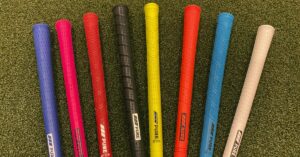Strong Vs Weak Golf Grip: Choosing The Right Grip
Golfers debate two types of grips: the strong grip and the weak grip. The right grip is crucial for a good game, and each type has its pros and cons, impacting golfing performance.
The main difference between a strong and weak golf grip is the position of your hands on the club. A strong grip involves positioning your hands more to the right on the club, while a weak grip involves positioning your hands more to the left.
In this blog post, we’ll explore the differences between a strong and weak golf grip and help you determine which one is best for your game.
Strong Vs Weak Golf Grip: What Are The Differences?
The golf grip is a fundamental aspect of the golf swing, and players can choose between a strong grip and a weak grip. The differences between the two can significantly impact a golfer’s performance on the course. Here are some differences:
| Aspect | Strong Grip | Weak Grip |
| Hand Position | Positioned to the right (for right-handed golfers) and vice versa for left-handed golfers. | Positioned more to the left (for right-handed golfers) and vice versa for left-handed golfers. |
| Thumb Placement | Thumb points more towards the golfer’s trailing shoulder. | Thumb points more towards the golfer’s leading shoulder. |
| Clubface Control | Tends to naturally close at impact, making it easier to draw the ball. | Tends to naturally open at impact, making it easier to fade the ball. |
| Shot Shape | Promotes a draw or reduces slices. | Promotes a fade or reduces hooks. |
| Grip Pressure | Often requires firmer grip pressure to avoid excessive clubface rotation. | Usually requires lighter grip pressure, allowing for more feel and finesse. |
| Shot Difficulty | Easier to control trajectory on low shots but may struggle with high shots. | Easier to control trajectory on high shots but may struggle with low shots. |
| Slice Correction | Helps correct slices, making it ideal for golfers with a slice tendency. | Might exacerbate a slice, making it challenging to correct slicing issues. |
Hand Position
The primary difference between a strong and weak grip lies in the positioning of the hands on the golf club.
For a strong grip, the hands are positioned more to the right (for right-handed golfers) and vice versa for left-handed golfers.
On the other hand, a weak grip places the hands more to the left (for right-handed golfers) and vice versa for left-handed golfers. The positioning affects how the clubface approaches the ball at impact.
Thumb Placement
In a strong grip, the golfer’s trail thumb (right thumb for right-handed golfers) points more towards their trailing shoulder. Conversely, in a weak grip, the trail thumb points more towards the golfer’s leading shoulder.
This difference in thumb placement impacts the golfer’s ability to square the clubface at impact.
Clubface Control
One of the significant implications of the grip choice is how it affects the clubface’s orientation at impact. A strong grip tends to naturally close the clubface, making it easier for golfers to draw the ball.
On the other hand, a weak grip tends to naturally open the clubface, making it easier to fade the ball. This directly influences shot shape and ball flight.
Shot Shape
Shot shape refers to the curvature of the golf ball during flight. A strong grip promotes a draw or reduces slices, as the closed clubface encourages a right-to-left ball flight for right-handed golfers.
Conversely, a weak grip promotes a fade or reduces hooks, as the open clubface encourages a left-to-right ball flight for right-handed golfers.
Grip Pressure
Grip pressure plays a crucial role in how a golfer controls the club during the swing. A strong grip often requires a firmer grip pressure to avoid excessive clubface rotation during the swing.
On the other hand, a weak grip allows for lighter grip pressure, providing the golfer with more feel and finesse in their shots.
Shot Difficulty
The choice of grip can influence shot difficulty under certain circumstances. With a strong grip, golfers may find it easier to control the trajectory on low shots but might struggle with higher shots due to the closed clubface.
Conversely, a weak grip might make it easier to control the trajectory on high shots, but lower shots could be more challenging to execute.
Slice Correction
For golfers with a slice tendency (a shot that curves severely from left to right for right-handed golfers), a strong grip can be advantageous.
It helps correct slices by promoting a draw ball flight, countering the slice spin. However, a weak grip might exacerbate a slice, making it more challenging to correct slicing issues.
Weak Golf Grip and Strong Golf Grip: What Are The Similarities?
The grip is a fundamental aspect of a golfer’s technique. While strong and weak golf grips differ, they share some common elements.
Hand Placement And Alignment
Both strong and weak golf grips require proper hand placement on the club and alignment with the target. The hands should work together cohesively to ensure a consistent swing path and clubface orientation at impact.
Finger Pressure
In both grips, maintaining the right amount of finger pressure is crucial. Gripping the club too tightly can lead to tension in the hands and arms, negatively affecting the swing. Conversely, too loose a grip can result in a lack of control over the club.
Neutral Wrist Position
A fundamental similarity between strong and weak golf grips is the need for a relatively neutral wrist position. While the specific positioning may vary slightly, avoiding excessive cupping or bowing of the wrists helps ensure a more consistent and reliable swing.
Connection Between Hands And Forearms
Regardless of whether a golfer adopts a strong or weak grip, maintaining a connection between the hands and forearms is essential for consistency and control. This connection helps promote a smooth transfer of power during the swing.
Adaptation To Swing Style
Both grip types can be effective, depending on a golfer’s swing style and preferences. Players with a more aggressive swing might find a stronger grip suitable, while those with a smoother swing may prefer a weaker grip. Finding the right balance for one’s swing is crucial for optimal performance.
Focus On Comfort And Feel
In both grip styles, golfers should prioritize comfort and feel in their hands. A grip that feels natural and allows the golfer to maintain control throughout the swing is essential for producing consistent and accurate shots.
Weak Golf Grip and Strong Golf Grip: Which One Is Better?
The golf grip is a fundamental aspect of a golfer’s technique and can be classified as either strong or weak.
A strong grip involves positioning the hands more to the right on the club (for right-handed golfers), causing the V formed by the thumb and index finger to point towards the right shoulder.
Conversely, a weak grip positions the hands more to the left, making the V point towards the chin.
The better grip depends on individual factors such as swing style, hand size, and flexibility. Generally, a neutral grip is recommended for beginners, as it promotes a more balanced swing and reduces the risk of slicing or hooking the ball.
Golfers need to work with a professional coach to determine the grip that suits their game best.
Frequently Asked Questions
If you’re a golfer, understanding the differences between a strong and weak grip is crucial for your swing and overall game. Let’s delve into some FAQs to clarify the distinctions.
Which Grip Is More Suitable For Beginners?
For most beginners, a neutral grip is recommended. It avoids extreme ball flight tendencies and provides better control during the learning process.
Can A Strong Grip Lead To Inconsistency?
Yes, an excessively strong grip might make it challenging to square the clubface consistently, resulting in wayward shots.
Is A Weak Grip Suitable For Players With A Slice?
Yes, a weak grip can help offset a slice, as it encourages an open clubface at impact, countering the curve.
Should I Change My Grip Based On The Club Selection?
It’s not necessary. Once you find a grip that suits your swing, maintain it across all clubs for consistency.
Can Grip Pressure Affect My Shots?
Absolutely. Gripping the club too tightly can hinder fluidity and reduce shot distance. Maintain a firm yet relaxed grip for optimal results.
How Can I Determine My Ideal Grip?
Experiment with different grip styles on the range. Assess how each affects your ball flight and comfort level, then choose the one that complements your swing and feels natural.






